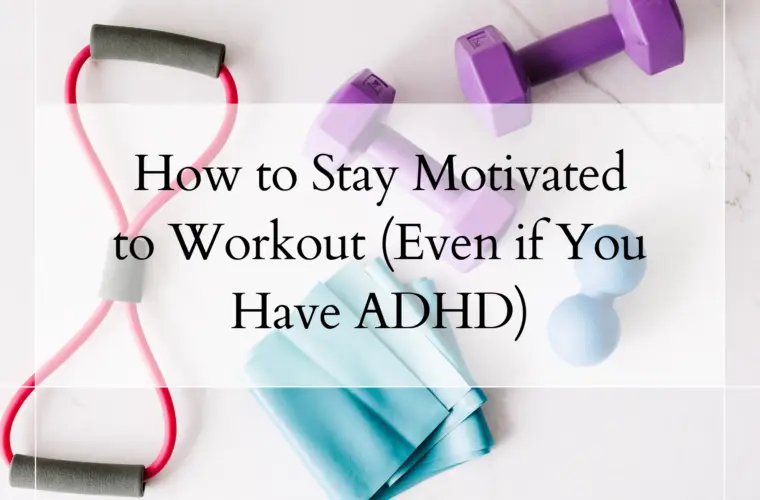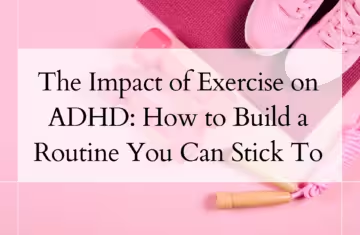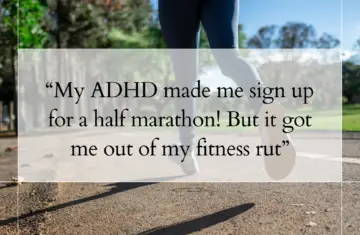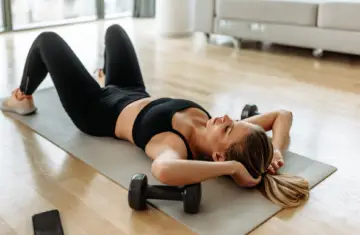We all know exercising is good for us. It makes you feel great afterwards, no doubt about that. You can even keep up a fitness routine for about 4-5 weeks when life is smooth.
Yet, every single time you start a new fitness routine, you end up falling out of that routine and slump back into that month’s long exercise hiatus.
Until it’s time to start all over again.
Getting into a new fitness routine is one thing, but learning how to stay motivated to workout after the newness and excitement has worn off is something else.
The good news is, with the right tweaks and figuring out what works for you, you can understand what motivates you and beat exercise boredom.
In this article I’m breaking down 7 ways to stay motivated to workout so that you can start getting fit without the self sabotage.
Avoid All or Nothing Thinking
My Dad always likes to say I go from 0 to 100mph with no inbetween. (He’s not wrong!) It’s a trait of us ADHDers. We like to do it all or nothing at all.
So when we have a fitness plan that says to workout 5x a week, we start by working out 5x a week. Then, the newness wears off, it gets a bit routine, a bit boring, life gets in the way and we end up skipping a day (or 2). Then we’ve fallen off the wagon and we give it up until next time
The trick is to stop trying to be perfect.
The only thing I can guarantee will happen to every single person on planet earth is this… they will make a plan and it will come along and get messed up!
It’s just life! No one can escape it. You’re just going to have to learn to go round it.
Start by lowering your expectations of yourself. Just because you didn’t workout this week or missed a couple of sessions, doesn’t mean you have failed.
This is why health coaches refer to making “lifestyle changes” ; it’s so you can learn to make exercising a habit. When you do that working out becomes part of who you are, not just something you do.
And this is the only approach that works long term.
Finding your why
I’ll tell you a story.
A few years ago I’d got into a fitness rut. I’d been consistent with the gym (and maybe hyper focused) since I was young. I’d done the Tracy Anderson Method for years. 1-2 hours of exercise a day! (madness). But I was exhausted by it and it was no longer getting me the results I wanted.
I tried many other workouts but I would start and then stop again after a few weeks or so. I just could not make myself get interested in working out anymore.
Other than some pilates I didn’t do much. I put some weight on but even that couldn’t motivate me to get out of my rut.
It was after I got diagnosed with ADHD, and spent a year trying to figure out how it affected me that I realised WHY my ADHD had become more apparent since stopping regular exercise and just doing pilates.
I needed cardio again. Cardio was much better at boosting my dopamine and serotonin levels than strength training alone.
So I got up and did 20 minutes on the rebounder every morning and 4x a week of pilates..
So what happened? Instantly, I felt better, after only a week, my ADHD symptoms became easier to manage, my medication didn’t give me a crash, I was able to take less, my PMDD was barely there and no menstrual cramps at all that month. All from adding in cardio.
That became my new motivator. My new why.
I knew that if I didn’t workout all those symptoms would appear again and I’d be on a downward spiral. I’d rather workout for 20 minutes than battle the dreaded PMDD every month!
In the end, I got out of my rut, and even began to look forward to exercise. All that I’d changed was my reason why.
Add Variety to Avoid Exercise Boredom
If you have ADHD or struggle with executive dysfunction then it’s more than likely you have found yourself falling off your exercise plan more than once and get bored by exercise.
That’s because the ADHD brain needs to be challenged and stimulated. Staring at ITV on the treadmill in the gym doesn’t always cut it. Here’s my advice.
First of all, prepare for boredom. Look at how long it usually takes for you to get bored of your exercise routine. How many weeks?
Then plan around that. It’s actually a good idea to switch up your exercise routine every 6 weeks anyway. Decide that for 4-6 weeks (or however long) you will focus on X. Then have another activity lined up that’ll excite you. Work with your ADHD and not against it.
I have lots of tips, tricks and ADHD friendly workout plans in my Fit and Focused with ADHD guide.
Challenge Your Mind as Well as Your Body
Choose workouts that force you to mentally engage. This can be as simple as following a workout video instead of slogging it on the exercise bike.
Try dance classes, Zumba, Pilates style classes like Body by Simone, The Sculpt Society and Tracy Anderson Method, where you learn sequences that keep you mentally challenged.
Work through programmes instead of individual workouts. This also takes away decision paralysis and challenges you to complete the full programme.
Even better, join an online workout community on Instagram (just search for hashtags on popular workout platforms like the SWEAT app & Joe Wicks) and share your journey. By connecting with others you can help yourself stay accountable and mentally stimulated.
Workout at Home
Don’t make it harder than it needs to be. The gym can feel overwhelming for a lot of people. There are so many more (unnecessary) steps. Finding an outfit, changing your clothes, finding the house keys, driving to the gym, finding a parking space, deciding what to do with all those machines once you actually get there…
Then you have to come back, wash your clothes, put them away.. It’s all extra work and, especially if you have ADHD, you want to keep it low effort. Because this may not seem daunting at first, but when the novelty of your new routine wears off then it will start to get tedious. It becomes another way for your brain to talk you out of it.
My advice, if you want to stay motivated to exercise, is to workout at home. You immediately get rid of all those extra steps and all those opportunities your brain has to talk you out of it.
And these days working out at home is easier than it ever has been. There are tons of free workout videos on You Tube. You can also sign up to streaming platforms online that give you tons of options for workouts from 10-60 minutes in every type of workout imaginable.
You don’t have to worry about your outfit, heck you can do it in your PJs! No one is watching.
Multi Task
It’s good to be present during your workout but if you struggle with that go for the next best thing. Binge watch your favourite show while walking on a treadmill. Get a walking pad for your desk. Find ways to incorporate exercise into your daily life.
Be Aware of the Impact of PMS/PMDD
Commonly I hear from women that they can only stick to an exercise routine for 3-4 weeks. Here’s what we often find. Their motivation is exactly in line with the menstrual cycle.
ADHD symptoms can get worse for women between 7-14 days before their period starts. As oestrogen supplies go down, dopamine and serotonin go down too, which leads to worsening executive dysfunction & ADHD symptoms. All of this has a knock on effect on you ability to stay motivated to exercise.
And, if you take stimulant medication for ADHD, you may find it’s less effective.
For me, even taking the highest dose of stimulant medication during the second part of the cycle has no effect whatsoever on my ADHD symptoms. Which is why I have to rely on holistic approaches such as diet, exercise, cycle syncing, stress management and mindfulness at this time.
It’s worth speaking to your doctor about changing doses during different phases of your menstrual cycle as some doctors are open to this. However, for many women making holistic approaches is preferred, or in some cases the only option.
If you find yourself struggling to keep up your motivation to workout for longer than a few weeks, then track your menstrual cycle and see if your motivation takes a hit in the week or two before your period starts.
Overall…
Understanding how to stay motivated to workout at home is crucial for your mental health, physical health & weight maintenance.
ADHD certainly brings its unique challenges. But, by incorporating variety, changing up your routine, being aware of how you’re feeling, mentally challenging yourself as well as physically and finding activities you enjoy will all help you stay motivated to workout so it feels less daunting and more fun.
For more help and support navigating healthy eating, meal prep and exercise with ADHD, make sure you’ve got a free copy of “Fit & Focused with ADHD”. Packed with ADHD diet advice, meal prep tips, fitness plans and recipes. All specifically with ADHD women in mind.
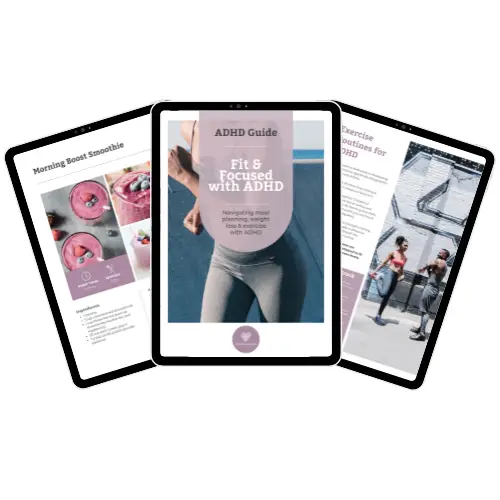
ADHD DIET & EXERCISE GUIDE
Fit & Focused with ADHD
This guide is designed to help you lose weight, manage your ADHD symptoms and beat exercise boredom. By the end of this guide, you’ll have a clear understanding of how diet impacts ADHD, why losing weight requires a different approach and have meal prep strategies and fitness plans to help you stay consistent.

